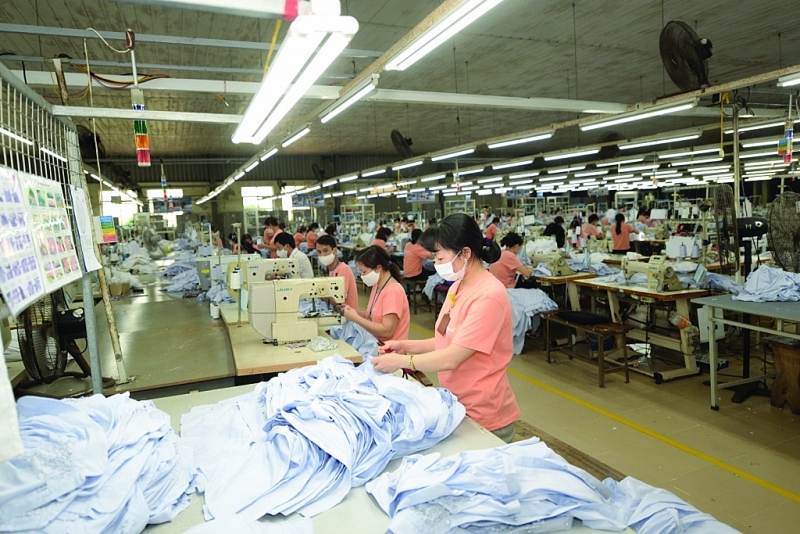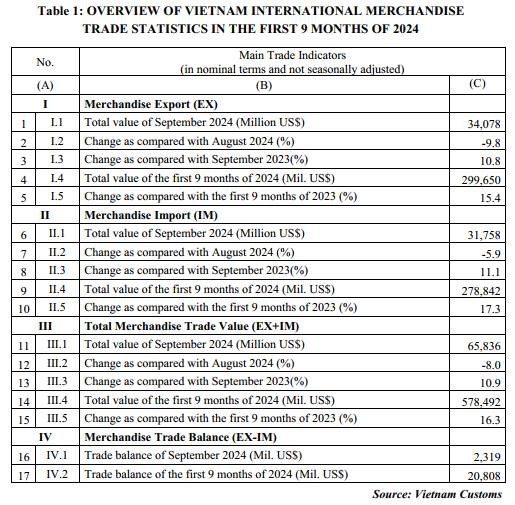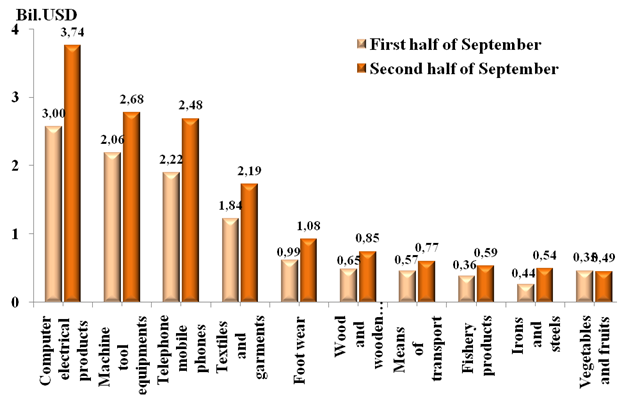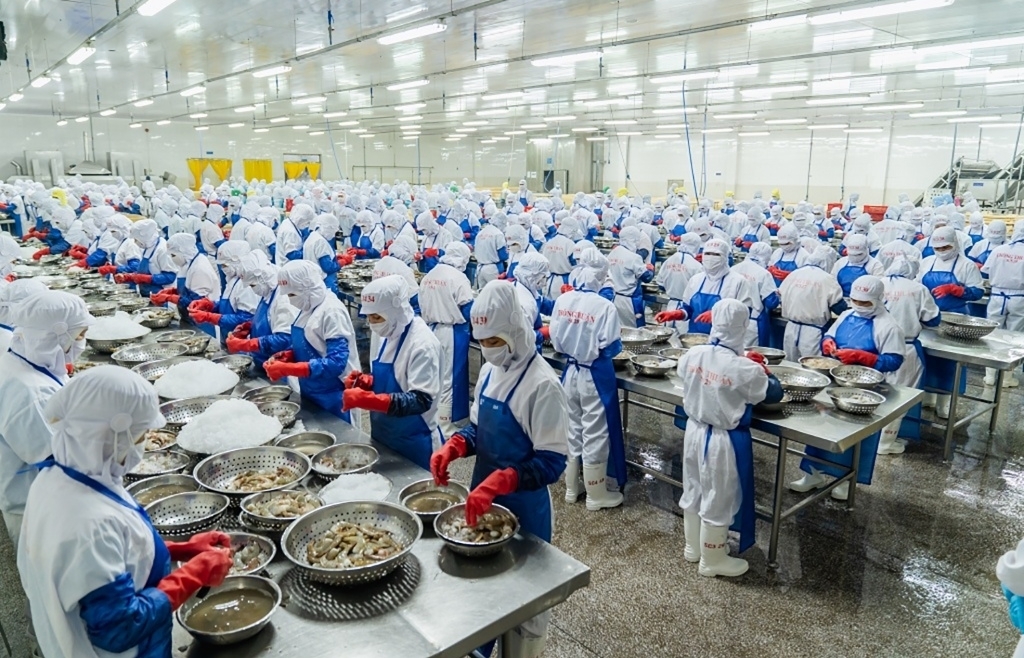To increase competitive capability for textiles
 |
| In order to improve competitiveness, a must is to gradually become self-sufficient in the fabric production industry. Photo: N.Thanh |
A large market is a fiercely competitive area
Thanks to a number of successful business cooperation with Vietnamese enterprises, Takko Company (Germany) is also looking forward to expanding its business, moving operations from China to Vietnam in order to find more many Vietnamese suppliers and expect to expand business activities in the future.
However, Mr. Radek Sorcik, Senior Director of Purchasing, Quality Management and Social Environment and Administration of Takko Company, said that Takko has a number of potential and high competitive product groups in its development strategy sụch as sportswear, outdoor clothing, t-shirts, trousers, meanwhile, these items of Vietnam have been facing a lot of competition with Bangladesh and China.
Therefore, Mr. Radek Sorcik suggested that, in order to expand the export of these products, Vietnamese enterprises must promote investing heavily in manufacturing plants, fabric quality, cost, and focus on researching and developing appropriate business strategies.
Sharing about the experience of domestic textile enterprises to improve their position in the international value chain, Mr. Shiotani Yuichiro, General Director of Vietnam Aeon TopValu said, compared with 30 years ago, the size of the garment industry Japan has shrunk by more than half. However, after the Covid-19 epidemic, the group of indoor apparel and products for outdoor activities and tourism had impressive growth, thereby contributing to the recovery of market size, gradually approaching the equivalent level to 2019.
Due to the full consumers' awareness of the Sustainable Development Goals (SDGs), Recycled, re-use, and repair apparel products are very active and are currently growing at 135% compared to 10 years ago,” said Mr. Shiotani. Moreover, Aeon is focusing on garments with built-in features, such as UV protection, waterproof... Besides, Aeon also captures the trend of made-up products from organic cotton, recycled polyester to apply to production and look forward to finding more partners with the same vision in Vietnam.
Fierce competition in major markets also requires a drastic transformation of the textile industry. According to Mr. Tran Minh Thang, Head of the San Francisco Trade Office - also said that the US is currently in demand for goods from Vietnam, but this is also a promising market for many foreign partners, therefore, Vietnamese businesses need to be persistent in approaching and offering products. In addition, businesses actively participate in trade promotion programs, fairs and exhibitions, connect with relevant agencies, create prestige and build customers' trust.
Raising competitiveness from self-reliance in raw materials
According to Mr. Shiotani, it is difficult to improve competitiveness of the garment industry through extensive development to increase the number of production units or reduce product costs. In the textile sector in Japan, factories operating under the labor-line model had to close down and only integrated ones stills remain, which is a lesson that the Japanese textile industry has learned many years ago.
Besides, the cost of fabric can account for 70-80% of the finished garment product's value, because the competitive advantage among processing facilities is labor cost. However, currently, labor costs in Vietnam are higher than in neighboring countries, while productivity remains. As a result, enterprises have to import fabrics and perform simple processing in addition to escalating distribution expenses, domestic enterprises have to suffer from a lot of pressure compared to competitive countries such as Cambodia, Myanmar, Bangladesh, etc. India. In order to improve competitiveness, the most necessary thing in the coming time is to gradually become self-sufficient in the fabric production industry.
For Fast Retailing Group (owner of the Uniqlo brand), Vietnam is one of the main production bases and the group wishes to continue its efforts to develop further, to ensure that Vietnam becomes a solid and key base in the production of textile products, improving the supply chain end-to-end (end-to-end).
According to Fast Retailing, the final production is no longer the key point in garment industry. Instead, the Group needs cooperation between inputs and outputs via the development a system domestic auxiliary and raw material factories. ,. If the input base in the production process is more solid, the Group can develop many improvements to the supply chain in Vietnam, which can further strengthen its presence in Vietnam through cooperation with partners. Besides, the development of human resources to improve input production capacity is one of the basic factors to increase the competitiveness of Vietnam's textile and garment in terms of price and quality.
Currently, Fast Retailing Group also sets many purchasing priorities for the Vietnamese market in particular and the global market in general, considering this as one of the important and essential goals in its development strategy. To accomplish that goal, Fast Retailing has introduced a series of policies to monitor and evaluate manufacturing partners.
In particular, Fast Retailing said, the group selects partners based on standards and quality assurance through regular monitoring and system audits to ensure quality in the production process and in the workplace. Moreover, Fast Retailing conducts the verification of the new partner factory before doing business to ensure the compliance between potential partners with the Manufacturing Partner Code. The Group only conducts business with qualified partners.
Related News

Preliminary assessment of Vietnam international merchandise trade performance in the first 9 months of 2024
09:22 | 20/11/2024 Customs Statistics

Preliminary assessment of Vietnam international merchandise trade performance in the second half of September, 2024
09:21 | 20/11/2024 Customs Statistics
Latest News

VN's food processing industry struggles to improve quality and value chain integration
15:53 | 22/11/2024 Import-Export

Approach strategy of the seafood industry when implementing UKVFTA
09:26 | 22/11/2024 Import-Export

Mid-November: Vietnam's trade volume matches 2023 total, eyes record-breaking growth
09:25 | 22/11/2024 Import-Export

Vietnamese enterprises facing challenges from cross-border e-commerce platforms
14:32 | 21/11/2024 Import-Export
More News

Vietnam, Malaysia eye new milestone in trade ties
14:29 | 21/11/2024 Import-Export
Shrimp exports surge in 10 months, generating 3.2 billion USD
14:27 | 21/11/2024 Import-Export

Vietnam’s exports to the U.S. near US$100 billion milestone
09:46 | 21/11/2024 Import-Export

From the “abnormal” coffee price, worries about the new crop
09:46 | 21/11/2024 Import-Export

What obstacles limit the market share of Vietnamese goods in the UK?
14:49 | 20/11/2024 Import-Export

Why seafood exports to some Middle Eastern Countries are stalled
14:47 | 20/11/2024 Import-Export

Storm No. 3 destroys profits of many insurance companies
14:45 | 20/11/2024 Import-Export

Vietnam, Malaysia eye golden partnership opportunities in Halal industry
14:44 | 20/11/2024 Import-Export

Tra fish sector aiming for production, processing greening for sustainable development
14:41 | 20/11/2024 Import-Export
Your care

VN's food processing industry struggles to improve quality and value chain integration
15:53 | 22/11/2024 Import-Export

Approach strategy of the seafood industry when implementing UKVFTA
09:26 | 22/11/2024 Import-Export

Mid-November: Vietnam's trade volume matches 2023 total, eyes record-breaking growth
09:25 | 22/11/2024 Import-Export

Vietnamese enterprises facing challenges from cross-border e-commerce platforms
14:32 | 21/11/2024 Import-Export

Vietnam, Malaysia eye new milestone in trade ties
14:29 | 21/11/2024 Import-Export





